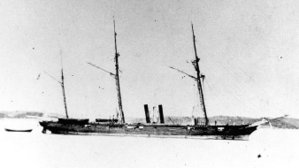 |
||||||||||||||||||||||||||||||
|
Home Ships Weapons Shipyards Newsletters Forums Contact Awards |
||||||||||||||||||||||||||||||
|
CSS Cruiser Florida was built by the British firm of William C. Miller & Sons and purchased by the Confederacy from Fawcett, Preston & Co., also of Liverpool, who engined her. Known in the shipyard as Oreto and initially called by the Confederates Manassas, the first of the foreign-built commerce raiders was commissioned Florida; Union records long continued to refer to her as Oreto or to confuse her with Alabama although, fitted with two funnels, she was readily distinguishable from single-stacked Alabama. Florida departed England 22 March 1862 for Nassau to coal and contrived to fill her bunkers, although entitled only to enough to make the nearest Confederate port. The Governor drew the line, however, at an attempted rendezvous with her tender in Nassau harbor; so she transferred stores and arms at isolated Green Cay. There she commissioned as Florida 17 August, with veteran Lt. John Newland Maffitt, CSN, in command. During her outfit, yellow fever raged among her crew, in 5 days reducing her effective force to one fireman and four deckhands. In desperate plight, she ran across to Cuba. There in Cardenas Maffitt too was stricken with the dread disease. In this condition, against all probability, the intrepid Maffitt sailed her from Cardenas to Mobile. In an audacious dash the "Prince of Privateers" braved a hail of projectiles from the Union blockaders and raced through them to anchor beneath the guns of Ft. Morgan for a hero's welcome by Mobile. Florida had been unable to fight back not only because of sickness but because rammers, sights, beds, locks and quoins had, inadvertently, not been loaded in the Bahamas. Having taken stores and gun accessories she lacked, along with added crew members, Florida escaped to sea 16 January 1863. After coaling at Nassau, she spent 6 months off North and South America and in the West Indies, with calls at neutral ports, all the while making captures and eluding the large Federal squadron pursuing her. (See also the exploits of Lieutenant Read under Clarence, Tacony, Archer and Caleb Gushing.) Florida sailed 27 July from Bermuda for Brest, where she lay in the French Government dock from 23 August 1863 to 12 February 1864. There broken in health, Maffitt relinquished command to Lieutenant Morris. Departing for the West Indies, Florida bunkered at Barbados, although the 3 months specified by British law had not elapsed since last coaling at an Empire port. She then skirted the U.S. coast, sailed east to Teneriffe in the Canaries and thence to Bahia, 4 October 1864. Anchored in the Brazilian haven, on 7 October Florida was caught defenseless in a night attack by Comdr. Napoleon Collins of USS Wachusett, while her captain was ashore with half his crew. Towed to sea, she was sent to the United States as a prize despite Brazil's protests at this violation of neutral rights. At Newport News, 28 November 1864, Florida reached the end of her strange career when she sank in a collision with the USAT Alliance, a troop ferry, and thus could not be delivered to Brazil in satisfaction of the final court order. Commander Collins was court-martialed but won fame and eventual promotion for his daring. Florida captured 37 prizes during her impressive career; her prizes Tacony and Clarence in turn took 23 more. |
|
|||||||||||||||||||||||||||||
|
Home Ships Weapons Shipyards Newsletters Forums Contact Awards Site owned and operated by CSA Media Copyright 2005
|
||||||||||||||||||||||||||||||
